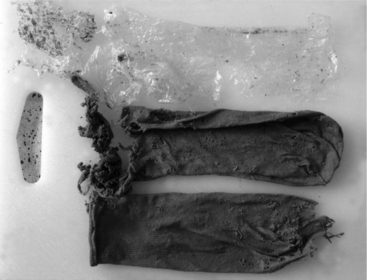Chapter 18 Surgery of the Sheep and Goat Digestive System
Gastrointestinal surgeries in sheep and goats are not commonly performed by the private veterinary practitioner but should always be considered for individual patients of economic worth. Surgeries that are performed most commonly include drainage or resection of pharyngeal abscess (traumatic, foreign body, caseous lymphadenitis), surgeries of the forestomach (reticulorumen) and abomasum, rumen and esophageal fistula placement, correction of intestinal obstruction, or intestinal accident.
When deciding on surgical points of entry, the practitioner should always consider the location of vessels and nerves in the area. An abscess should be entered from the oral cavity whenever possible (and when attached to the oropharynx) (see Figure 10.1-5) and lanced so that it drains into the digestive system. This is best accomplished by aspirating the contents first with an 18-gauge needle and syringe. A larger gauge needle will be needed in those instances when the abscess capsule may be thick.
Surgery of the Rumen
Disease of the forestomach (reticulorumen) can be fairly common in sheep and goat practice. Ruminal distention, rumen acidosis, rumen impaction, bezoar formation, and foreign body consumption (Figure 18-1) with subsequent impaction and rumenitis/reticulitis are conditions that may require surgical intervention. Advanced rumenitis generally has a poor surgical prognosis. Rumenotomy and/or trocar placement can be required to correct the other conditions.

Figure 18-1 Foreign bodies (plastic bags) ingested by a goat resulting in ruminal obstruction.
(Courtesy of Dr. Mary Smith; Cornell University.)
If a rumenotomy is not performed under emergency conditions, the patient should be held off feed for 12 to 24 hours before surgery. General anesthesia helps control animal movement and maintains a clean surgical field. However, if economics preclude general anesthesia use, a rumenotomy can be done with a local anesthetic and manual restraint. The practitioner should be aware that sheep and goats are highly susceptible to the toxic effects of lidocaine; therefore low volumes of diluted (1%) lidocaine should be used.
The patient is placed in lateral recumbency with the right side down and the left flank prepared for aseptic surgery. For a rumenotomy, a 15-cm vertical skin incision is made parallel and 5 cm caudal to the last rib. The underlying muscle layers can either be sharply incised or bluntly dissected along their fascia planes (“grid technique”) if a small incision is needed. Sheep and goat muscle layers are much thinner than those in cattle, and there is a more prominent cutaneous trunci muscle. Surgeons not used to small ruminants need to be careful not to make the common mistake of being too aggressive on the abdominal approach or incising over the kidneys. Once the rumen has been visualized, 10 cm should be exteriorized and sutured to the skin of the wound margin with a Lembert-type pattern around the entire incision margin. A bite is taken through the skin; then a bite is taken through the rumen (see Figure 10.3-10). This suture pattern forms a seal that prevents rumen fluid from entering the abdomen and is important to the surgery’s success. Once the suture placement is inspected and found intact, the rumen wall is incised within this margin. The surgeon should avoid traumatizing the rumen wall as much as possible.
Rumenotomies to remove a foreign body have the most favorable prognosis. The most common items found in the rumen are plastic bags, rope, and large foreign bodies. A rumenotomy can also be performed for toxic indigestion; however, the prognosis is guarded for conditions longer than 12 hours’ duration. Medical management of these cases through intravenous fluids, electrolyte monitoring and replacement therapy, probiotics, and orogastric introduction of alfalfa meal or feed mill “fines” is usually as—or more—successful. Alkalizers* may also be helpful. Stabilization of the rumen pH and transfaunation can be important tools for successful case management. Transfaunation per os generally requires 250 to 500 ml of collection fluid 2 to 3 times daily for 3 to 5 days. This fluid should be kept anaerobic, at rumen temperature, and out of light until inoculation occurs. Ideally, the time from collection to transfaunation should be less than 30 minutes.
ABOMASAL SURGERY
Disease of the abomasum is much less common than in cattle and decidedly more difficult to manage surgically. Abomasal impaction, abomasitis, perforating abomasal ulcers, abomasal foreign bodies and abomasal emptying defect (AED) in Suffolk sheep can potentially be managed with surgical intervention. However, in most instances medical management should be attempted initially.
Stay updated, free articles. Join our Telegram channel

Full access? Get Clinical Tree


